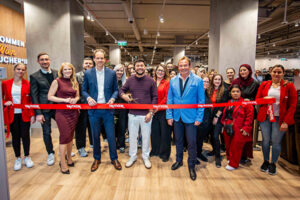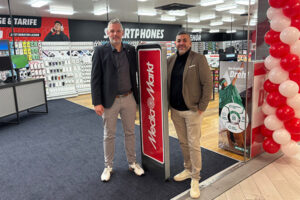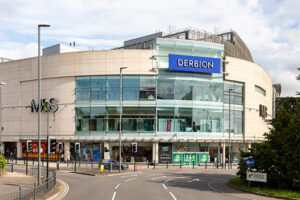ACROSS: What stands out about the expansion of Samsonite since the company’s founding in 1910?
CARTER: I think it is our ability to expand across the world. This is our most significant asset. The company was founded in North America. From there, we went to Europe and eventually Asia and South America. Samsonite’s main strength is that it operates in all these territories. We were in a number of countries at an early stage. For example, we’ve been present in China since the 1990s. In addition, and independent from the expansion, we have been leaders in product development. Our philosophy is: “Continuously innovate.” In this sense, we are always “ahead of the game” in our industry, i.e. in all luggage-related areas.
ACROSS: You bought Chic Accent, a chain of retail stores in Italy dedicated to the sale of premium accessories, ladies’ handbags, luggage, travel, and business products, for a total cash consideration of €8.5 million in October. What is the motivation behind the deal?
CARTER: It is important to distinguish between two points in this. On the one hand, we are increasing the number of our brands with this acquisition. Apart from Samsonite, these include American Tourister, Hartmann, High Sierra, Gregory, Speck and Lipault. Thanks to the numerous brands, we are represented in all the categories in the industry. This is key because it is a priority for us to develop Samsonite from the most important luggage company that also does great bags into the most important bag company that also does great luggage. After all, the bag industry is among the most significant in the world.
On the other hand, the acquisition of Chic Accent also strengthens our retail footprint. It’s common knowledge that one of the most effective ways to establish a firm retail footprint is to buy an established brand – like Chic Accent, with its 31 stores in Italian high-end shopping malls, including many multi-brand stores. We’re thus paying tribute to the fact that the retail landscape has changed dramatically over the last twenty years. Mono-brand stores often have to contend with problems. Multi-brand stores work very well in Chic Accent’s locations. Samsonite stores, meanwhile, are more appropriate for premium locations. Overall, we are definitely very well diversified.
ACROSS: You mentioned that Chic Accent is primarily present in shopping malls. How important are malls as locations for Samsonite in general?
CARTER: Shopping centers were not top targets previously. Since our company is a brand, we’ve tended to focus instead on showrooms and the like. This has now changed somewhat. Our interest in malls as locations is increasing, especially from the multi-brand point of view. These malls have to have excellent and guaranteed frequency, however. This is where terms like “quality of stay” and “purchasing power” come into play. The acquisition of Chic Accent means – as mentioned – that our commitment to malls has increased significantly. In addition, we recently opened two stores in Westfield in London, for example.
ACROSS: Samsonite also has stores in outlet centers. How important are outlet center as venues for you?
CARTER: In line with our business model, outlet centers are essential for us to clean up our product lines with reduced prices. We also have some key venues in outlet centers in European capitals that showcase the Samsonite brand perfectly. We currently have more than sixty stores in outlet centers and continue to look at the most important new openings. We are aware, however, that this retail segment is an almost saturated market. Our main strategy is therefore to focus on footprint retail and multi-brand concepts.
ACROSS: Do you adapt your range to the individual needs of the local population?
CARTER: Yes, absolutely. With locations in malls, we benefit in this regard from demographic statistics made available by the center-management. We adapt our product range accordingly. We also use these statistical data to conclude which of our brands is best suited to the particular shopping center. American Tourister is very colourful, for example, whereas Lipault tends to be more fashionable. We do not usually mix such different brands because that would confuse the customers too much. We make an individual decision for every mall and outlet center on how we will position ourselves and with what.
Seasonal themes of course also play a role in the adaptation of the assortment. For example, we prepare ourselves for the start of school. For that, we have produced our own Disney collection and special backpacks, for example. At Christmas, in turn, we boost our gift department. In general, we try to be very flexible in the range design. On this point, shopping centers accommodate us quite nicely, as they ensure us this flexibility.
ACROSS: How does Samsonite’s multichannel strategy look?
CARTER: We have developed a website with an online shop for each of our brands. How much of each brand is sold over the internet varies considerably. It is clear that the traffic – and thus the generated revenue – on the well-known Samsonite site stands out positively. Moreover, we don’t consider our sites to be just commercial tools. Instead, they primarily meet classical marketing goals for us by offering content like videos. In addition, many of our business partners use them as a reference.
ACROSS: How has the market for luggage in general changed since Samsonite’s founding?
CARTER: Our market benefits from the fact that people in times of crisis give up lots of things – but not vacations. The market for luggage more or less follows the market for air travel. Thus, we see our business expanding. Of course, epidemics like SARS or conflicts such as the Gulf War have a negative influence on us in this context.
Regarding the products, the replacement of soft suitcases with hard-shelled suitcases has changed the market significantly. The advantage of soft suitcases was that they were light. Nowadays, however, even hard-shelled suitcases are impressively light as well as more robust.





